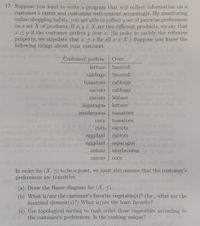
Advanced Engineering Mathematics
10th Edition
ISBN: 9780470458365
Author: Erwin Kreyszig
Publisher: Wiley, John & Sons, Incorporated
expand_more
expand_more
format_list_bulleted
Concept explainers
Topic Video
Question
Essentials of DISCRETE MATHEMATICS:
Section 2.5- Partial Orderdings

Transcribed Image Text:17. Suppose you want to write a program that will collect information on a
customer's tastes and customize web content accordingly. By monitoring
online shopping habits, you are able to collect a set of pairwise preferences
on a set X of products. If x, y EX are two different products, we say
x 3y if the customer prefers y over x. (In order to satisfy the reflexive
property, we stipulate that x 3x for all a E X.) Suppose you know the
following things about your customer.
that
Customer prefers:
Over:
lettuce
broccoli
cabbage broccoli
cabbage
tomatoes
carrots
cabbage
carrots
lettuce
asparagus
lettuce
mushrooms
tomatoes
corn
tomatoes
corn
carrots
eggplant
carrots
eggplant
asparagus
onions
mushrooms 2
onions
corn
In order for (X,<) to be a poset, we must also assume that the customer's
preferences are transitive.
(a) Draw the Hasse diagram for (X, 3).
(b) What is/are the customer's favorite vegetable(s)? (I.e., what are the
maximal element (s)?) What is/are the least favorite?
(c) Use topological sorting to rank order these vegetables according to
the customer's preferences. Is the ranking unique?
Expert Solution
This question has been solved!
Explore an expertly crafted, step-by-step solution for a thorough understanding of key concepts.
This is a popular solution
Trending nowThis is a popular solution!
Step by stepSolved in 4 steps with 1 images

Knowledge Booster
Learn more about
Need a deep-dive on the concept behind this application? Look no further. Learn more about this topic, advanced-math and related others by exploring similar questions and additional content below.Similar questions
- Section 3.2: HG #6) verity that the function Satisfiees the three hypotheses of kolle's theorem on the given interval. Then find all numbers c that satisfy the conclusion of ROlle's Theorem. fax)=x3-2x²-4x +2, [-2,2] toarrow_forwardLinear Algebra Question: Suppose x1, x2, x3 are 3-tuples in R^3 satisfying the following: a. x1 is orthogonal x2. b. x2 is orthogonal to x3. Must it be the case that x1 is orthogonal x3? If so, prove the claim. If not, explain why, and give a counterexample.arrow_forwardQ4 Revenue equivalence Ill Consider a sealed-bid auction in which the highest-bidder wins and pays the amount that they bid and the lowest bidder receives a payment equal to the difference between the first- and second-highest bids. Does this auction pay the seller the same revenue as the four standard auctions? (That is, does the revenue equivalence theorem apply here?) Why or why not? Be specific.arrow_forward
Recommended textbooks for you
 Advanced Engineering MathematicsAdvanced MathISBN:9780470458365Author:Erwin KreyszigPublisher:Wiley, John & Sons, Incorporated
Advanced Engineering MathematicsAdvanced MathISBN:9780470458365Author:Erwin KreyszigPublisher:Wiley, John & Sons, Incorporated Numerical Methods for EngineersAdvanced MathISBN:9780073397924Author:Steven C. Chapra Dr., Raymond P. CanalePublisher:McGraw-Hill Education
Numerical Methods for EngineersAdvanced MathISBN:9780073397924Author:Steven C. Chapra Dr., Raymond P. CanalePublisher:McGraw-Hill Education Introductory Mathematics for Engineering Applicat...Advanced MathISBN:9781118141809Author:Nathan KlingbeilPublisher:WILEY
Introductory Mathematics for Engineering Applicat...Advanced MathISBN:9781118141809Author:Nathan KlingbeilPublisher:WILEY Mathematics For Machine TechnologyAdvanced MathISBN:9781337798310Author:Peterson, John.Publisher:Cengage Learning,
Mathematics For Machine TechnologyAdvanced MathISBN:9781337798310Author:Peterson, John.Publisher:Cengage Learning,


Advanced Engineering Mathematics
Advanced Math
ISBN:9780470458365
Author:Erwin Kreyszig
Publisher:Wiley, John & Sons, Incorporated

Numerical Methods for Engineers
Advanced Math
ISBN:9780073397924
Author:Steven C. Chapra Dr., Raymond P. Canale
Publisher:McGraw-Hill Education

Introductory Mathematics for Engineering Applicat...
Advanced Math
ISBN:9781118141809
Author:Nathan Klingbeil
Publisher:WILEY

Mathematics For Machine Technology
Advanced Math
ISBN:9781337798310
Author:Peterson, John.
Publisher:Cengage Learning,

